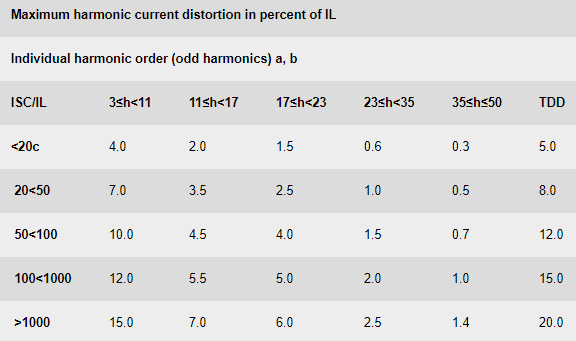IEEE Std 519-2022 is a newly published revision to the IEEE Recommended Practice and Requirements for Harmonic Control in Electric Power Systems. It supersedes the IEEE Std 519-2014 and 1992 revision.
The overarching goal of the 2022 revision is the same as the 2014 and 1992 version; to define the specific and separate responsibilities for each participant – utilities and users – to maintain the voltage THD within acceptable limits at the Point of Common Coupling (PCC) between the utility and the user, and protect the user and utility equipment from the negative impact of harmonics. The separate individual responsibilities are:
- User – limit harmonic currents at the PCC to prescribed levels
- Utility – limit voltage distortion at the PCC to prescribed levels by maintaining system impedance as necessary
To determine if your systems are compliant with IEEE 519-2014, use the HarmonicGuard® Solution Center.
Main Updates and Changes That May Affect You
Applying Harmonic Limits at the PCC Between Utility and User
The 2022 version re-emphasizes and clarifies IEEE Std 519, as written, is to be applied at the PCC – the point of common coupling between the utility and the user.
The size reduction of the document and the removal of conflicting material aids tremendously in clarifying:
- The standard is designed to be applied at the PCC
- The PCC is the point of common coupling between the utility and user
Current distortion limits for systems rated 120 V through 69 kV
a Even harmonics are limited to 25% of the odd harmonic limits above.
b Current distortions that result in a dc offset, e.g., half-wave converters, are not allowed.
c All power generation eqipment is limited to these values of current distortion, regarless of actual ISC/IL.
where
ISC = maximum short-circuit current at PCC
IL = maximum demand load current (fundamental frequency component) at the PCC under normal load operating conditions.
Current THD Limits at the PCC
A change was made to the Current Distortion Limits table to document what has been practiced in the field for many years – limiting the assessment of harmonic currents up to a maximum of the 50th harmonic. This is accomplished by clearly stating the maximum individual harmonic range is 35th≤h≤50th.
Voltage THD Limits at the PCC
A new lower PCC voltage range of V≤1.0kV was defined with higher allowable harmonic voltage limits: Individual Harmonic at 5% and Total Harmonic Distortion at 8%. These limits are higher than the next highest voltage range 1.0kV<V≤69kV.
High Frequency Current Allowance in Low Current Distortion Systems
IEEE 519-2022 provides for an allowance of higher high-order harmonic current limits at a PCC that has low lower-order harmonics. The allowance is applied to Table 2, Current Distortion Limits, if a prescribed minimum performance level is met. For example, if a power system with Isc/IL< 20 has 5th and 7th harmonic currents at <1% then all other harmonic limits in Table 2 may be exceeded up to a factor of 1.4 and still be in compliance.
Measurements
The IEEE Std 519-2022 version clearly defines the statistical measurement levels for determining compliance. The measurement methods will be especially useful for power systems with large amounts of cyclical loads or a power system with varying loads and distortion levels.
As described in more detail in the standard, the three statically based limit bands are:
- Daily 99th percentile harmonic currents should be less than 2 times the Current Distortion limits.
- Weekly 99th percentile harmonic currents should be less than 1.5 times the Current Distortion limits.
- Weekly 95th percentile harmonic currents should be less than 1.0 times the Current Distortion limits.
Format Changes
The 2014 revision is a vastly simplified document compared to the 1992 version. A significant amount of educational material on generation and measurement of harmonics was either deleted or moved from the main body of the document into the appendices. For example, some of the sections that were removed include:
- Section 4 – Harmonic Generation: typical converters that produced harmonics
- Section 5 – System Response Characteristics: details on power system resonance and interaction with converters and power factor correction capacitors
- Section 6 – Effects of Harmonics including impacts on transformers, capacitors and meters
- Section 7 – Reactive Power Compensation and Harmonic Control: Typical passive filter circuits
- Sections 8 & 9 – Mathematic techniques to address THD calculations and measurements
Sections or information from the 1992 version that were moved to the 2014 version’s appendices and simplified are:
- Interharmonics and flicker
- Telephone Influence Factor (TIF)
- Notch depth for limits SCR rectifiers
Additional key sections from the 1992 version that have been consolidated and made more concise:
- Section 9 – Measurements of harmonics
- Section 10 – Harmonic voltage current limits
- Section 11 – Addressing harmonic voltage limits
Interested parties may refer back to the 1992 version for educational details when needed.
IEEE Societies
The IEEE Std 519-1992 was a product of and collaboration between two IEEE Societies:
- Transmission and Distribution Committee of the IEEE Power and Engineering Society
- Static Power Converter Committee of the IEEE Industry Applications Society
The IEEE Std 519-2014 document is a product of one IEEE Society, The Transmission and Distribution Committee of the IEEE Power and Energy Society.
Conclusions
IEEE Std 519-2014 is a newly published revision to the IEEE Recommended Practice and Requirements for Harmonic Control in Electric Power Systems. It supersedes the revision IEEE Std 519-1992. This document summarizes key changes and updates made in this latest version.
Your system’s compliance with IEEE 519-2014 can be determined with the HarmonicGuard® Solution Center.
References
[1] “IEEE Recommended Practices and Requirements for Harmonic Control in Electrical Power Systems”, IEEE Std. 519-1992.
[2] “IEEE Recommended Practices and Requirements for Harmonic Control in Electrical Power Systems”, IEEE Std. 519-2014.

